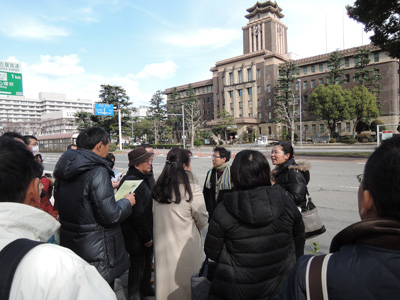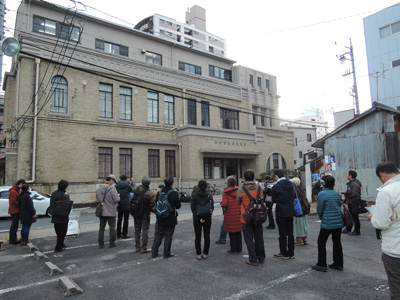
Date and time Saturday, February 6 13:30 to 16:30
Visit Nagoya City Municipal Museum, Former Toyota Sasuke House, Nagoya Ceramics Hall, etc.
On February 6, we held a tour entitled "A tour of modern architecture in Nagoya". This is a project to look around the modern architecture that remains around the Shirakabe area. Instructor is Kazumitsu Sakai of the Osaka Museum of History and Kan Murayama of the Tajimi City Mosaic Tile Museum. Mr. Sakai explained his position as a modern architecture, and Mr. Murayama further explained the tiles that are frequently used in exterior and interior.


First, we toured the Nagoya City Hall, which was completed in 1933 and the Aichi Prefectural Government Building, which was completed in 1938, from outside. All are steel-framed reinforced concrete, and tiles are attached to the exterior. The city hall uses high-quality tiles to the interior, but it is amazing that the prefectural government building itself was built at the time when material control began.
.jpg)
Next is the Nagoya City Municipal Museum. This building was built as a courthouse in 1922. This is mainly composed of bricks and reinforced concrete, and a small size makeup brick is attached to the exterior. Inside, there were various expressions such as stained glass and pillars depicting marble patterns in plaster. It is also known as a pioneering example of the preservation of modern architecture in Nagoya.
.jpg)
Next, the former Toyoda Sasuke residence and the former Haruta Tetsujiro residence. They are all built in the late Taisho era. The exterior of the former Toyota House Western-style building is white tiled, and if you look closely, it uses a ring covering fabric. On the other hand, the former Haruta House is a valuable building designed by architect Goichi Takeda.
.jpg)
Next, I visited the Bunka no Michitsugikan. This is the residence of the ceramic trader Tamezaburo Imoto, built from the end of the Taisho era to the early Showa era, and uses plenty of high-quality tiles, such as kitchens and Western-style solar rooms.

Finally, the Nagoya Ceramics Hall was completed in 1932. The outer wall is a thick scratch tile of glaze, creating a rich atmosphere with expressive appearance.
.jpg)
As for the interior, the tiles tightly packed on the floor and the staircase waist wall are impressive, especially the pentagonal "diamonds" that are arranged neatly on the floor of the entrance are valuable.
Nagoya, as well as the production areas of pottery such as Tokoname, Seto, and Mino are nearby, modern architecture in Nagoya is very fulfilling. I was rushed because I looked around a lot of greedy, but it was a luxurious tour where I could compare various expressions and expressions of buildings from the end of Taisho era to the early Showa era in one day.
Many of the facilities we visited this time are open to the public. Along with the "Challenge of Modern Architecture Manufacturing" exhibition, please take a look at the valuable modern architecture that remains in the city.
